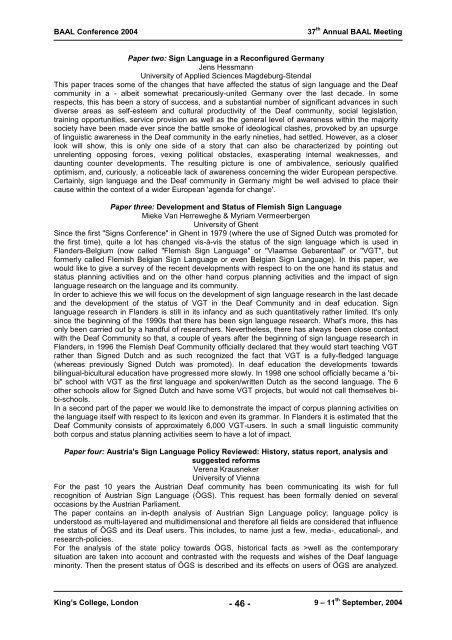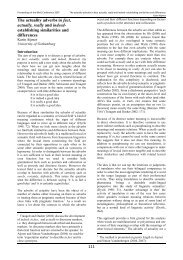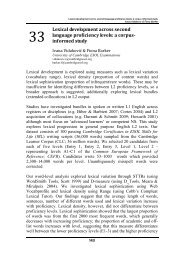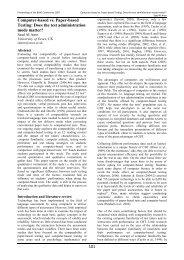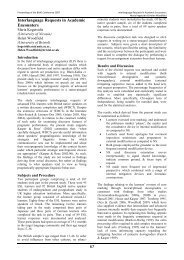Colloquia - British Association for Applied Linguistics
Colloquia - British Association for Applied Linguistics
Colloquia - British Association for Applied Linguistics
You also want an ePaper? Increase the reach of your titles
YUMPU automatically turns print PDFs into web optimized ePapers that Google loves.
BAAL Conference 2004 37 th Annual BAAL Meeting<br />
Paper two: Sign Language in a Reconfigured Germany<br />
Jens Hessmann<br />
University of <strong>Applied</strong> Sciences Magdeburg-Stendal<br />
This paper traces some of the changes that have affected the status of sign language and the Deaf<br />
community in a - albeit somewhat precariously-united Germany over the last decade. In some<br />
respects, this has been a story of success, and a substantial number of significant advances in such<br />
diverse areas as self-esteem and cultural productivity of the Deaf community, social legislation,<br />
training opportunities, service provision as well as the general level of awareness within the majority<br />
society have been made ever since the battle smoke of ideological clashes, provoked by an upsurge<br />
of linguistic awareness in the Deaf community in the early nineties, had settled. However, as a closer<br />
look will show, this is only one side of a story that can also be characterized by pointing out<br />
unrelenting opposing <strong>for</strong>ces, vexing political obstacles, exasperating internal weaknesses, and<br />
daunting counter developments. The resulting picture is one of ambivalence, seriously qualified<br />
optimism, and, curiously, a noticeable lack of awareness concerning the wider European perspective.<br />
Certainly, sign language and the Deaf community in Germany might be well advised to place their<br />
cause within the context of a wider European 'agenda <strong>for</strong> change'.<br />
Paper three: Development and Status of Flemish Sign Language<br />
Mieke Van Herreweghe & Myriam Vermeerbergen<br />
University of Ghent<br />
Since the first "Signs Conference" in Ghent in 1979 (where the use of Signed Dutch was promoted <strong>for</strong><br />
the first time), quite a lot has changed vis-à-vis the status of the sign language which is used in<br />
Flanders-Belgium (now called "Flemish Sign Language" or "Vlaamse Gebarentaal" or "VGT", but<br />
<strong>for</strong>merly called Flemish Belgian Sign Language or even Belgian Sign Language). In this paper, we<br />
would like to give a survey of the recent developments with respect to on the one hand its status and<br />
status planning activities and on the other hand corpus planning activities and the impact of sign<br />
language research on the language and its community.<br />
In order to achieve this we will focus on the development of sign language research in the last decade<br />
and the development of the status of VGT in the Deaf Community and in deaf education. Sign<br />
language research in Flanders is still in its infancy and as such quantitatively rather limited. It's only<br />
since the beginning of the 1990s that there has been sign language research. What's more, this has<br />
only been carried out by a handful of researchers. Nevertheless, there has always been close contact<br />
with the Deaf Community so that, a couple of years after the beginning of sign language research in<br />
Flanders, in 1996 the Flemish Deaf Community officially declared that they would start teaching VGT<br />
rather than Signed Dutch and as such recognized the fact that VGT is a fully-fledged language<br />
(whereas previously Signed Dutch was promoted). In deaf education the developments towards<br />
bilingual-bicultural education have progressed more slowly. In 1998 one school officially became a 'bibi"<br />
school with VGT as the first language and spoken/written Dutch as the second language. The 6<br />
other schools allow <strong>for</strong> Signed Dutch and have some VGT projects, but would not call themselves bibi-schools.<br />
In a second part of the paper we would like to demonstrate the impact of corpus planning activities on<br />
the language itself with respect to its lexicon and even its grammar. In Flanders it is estimated that the<br />
Deaf Community consists of approximately 6,000 VGT-users. In such a small linguistic community<br />
both corpus and status planning activities seem to have a lot of impact.<br />
Paper four: Austria's Sign Language Policy Reviewed: History, status report, analysis and<br />
suggested re<strong>for</strong>ms<br />
Verena Krausneker<br />
University of Vienna<br />
For the past 10 years the Austrian Deaf community has been communicating its wish <strong>for</strong> full<br />
recognition of Austrian Sign Language (ÖGS). This request has been <strong>for</strong>mally denied on several<br />
occasions by the Austrian Parliament.<br />
The paper contains an in-depth analysis of Austrian Sign Language policy; language policy is<br />
understood as multi-layered and multidimensional and there<strong>for</strong>e all fields are considered that influence<br />
the status of ÖGS and its Deaf users. This includes, to name just a few, media-, educational-, and<br />
research-policies.<br />
For the analysis of the state policy towards ÖGS, historical facts as >well as the contemporary<br />
situation are taken into account and contrasted with the requests and wishes of the Deaf language<br />
minority. Then the present status of ÖGS is described and its effects on users of ÖGS are analyzed.<br />
King‟s College, London 9 – 11 th - 46 -<br />
September, 2004


